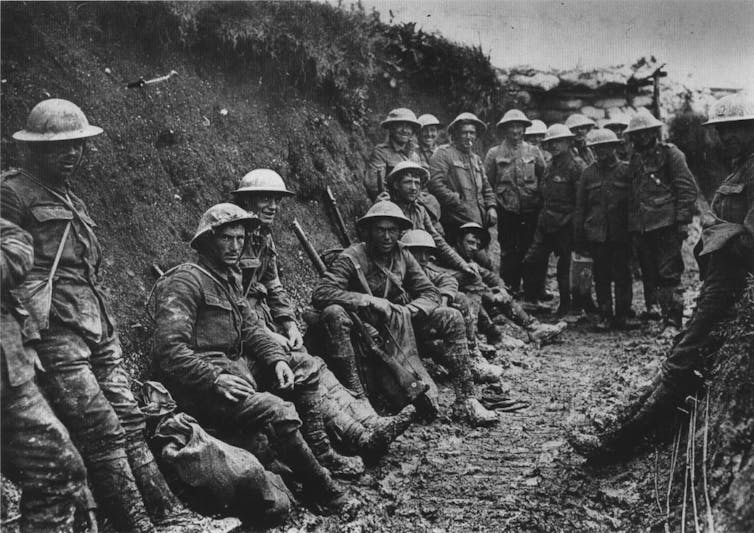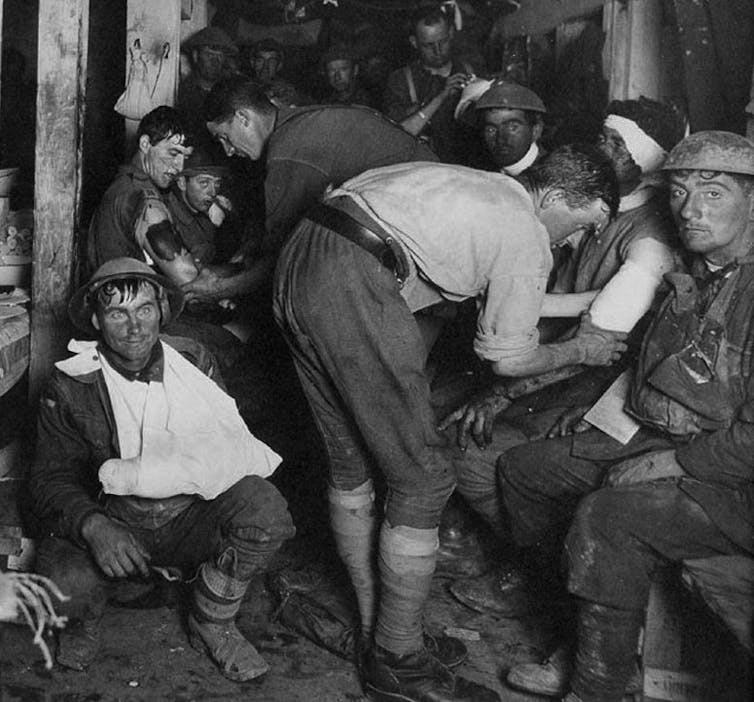People often experience trauma during war. Over time, this can develop into a condition we now recognise as post-traumatic stress disorder (PTSD). Sufferers can experience severe anxiety, flashbacks, nightmares, insomnia and anger, amongst other symptoms.
It has a long history. Cases of PTSD have been identified from descriptions in ancient Greek history of people experiencing persistent nightmares. Other symptoms, such as feeling anxious and constantly on edge, were described as “soldier’s heart” during the American Civil War. But this history took a sharp turn a hundred years ago, during World War I, when the prevalence of what was then known as “shell-shock” meant that a formal treatment for psychological trauma was needed.

Psychological trauma experienced during the war had an unprecedented toll on veterans, many of whom suffered symptoms for the rest of their lives. These ranged from distressing memories that veterans found difficult to forget, to extreme episodes of catatonia and terrorwhen reminded of their trauma. The sheer scale of veterans experiencing such symptoms after World War I led to the definition of “combat stress reaction”, informing our modern concept of PTSD.
The public perception of PTSD is still rooted in this past, and some of the problems discovered during World War I regarding psychological trauma have not yet been answered. Though much has changed, many principles and challenges of PTSD treatment were first identified during World War I. If we are to learn lessons from the war and better acknowledge the sacrifices of those who served, we must also acknowledge the impact of psychological trauma, both then and now.
Shell-shock
Soldiers described the effects of trauma as “shell-shock” because they believed them to be caused by exposure to artillery bombardments. As early as 1915, army hospitals became inundated with soldiers requiring treatment for “wounded minds”, tremors, blurred vision and fits, taking the military establishment entirely by surprise. An army psychiatrist, Charles Myers, subsequently published observations in the Lancet, coining the term shell-shock. Approximately 80,000 British soldiers were treated for shell-shock over the course of the war. Despite its prevalence, experiencing shell-shock was often attributed to moral failings and weaknesses, with some soldiers even being accused of cowardice.

But the concept of shell-shock had its limitations. Despite coining the term, Charles Myersnoted that shell-shock implied that one had to be directly exposed to combat, even though many suffering from the condition had been exposed to non-combat related trauma (such as the threat of injury and death). Cognitive and behavioural symptoms of trauma, such as nightmares, hyper-vigilance and avoiding triggering situations, were also overlooked compared to physical symptoms.
Today, it is these cognitive and behavioural symptoms that define PTSD. The physical symptoms that defined shell-shock are often consequences of these nonphysical symptoms.
Treating shell-shock
Treatments were harsh. As depicted in Pat Barker’s novel Regeneration, shell-shock patients could receive courses of electroshock therapy and physical conditioning, with the aim of alleviating physical symptoms quickly.
Not only were such treatments brutal, they were typically ineffective, with 80% of those treated unable to serve again. They were very commonly used to treat physical symptoms such as fits and tremors, as shown in the video below. While the man in the video is shown walking again, it is unknown if psychological symptoms were alleviated.
Due to the ineffectiveness of prescribed treatments, many soldiers who had witnessed trauma or experienced shell-shock attempted to self-medicate their symptoms. Alcohol and drug use were common methods to treat immediate symptoms, much like Captain Stanhope’s use of alcohol to cope with the onset of anxiety in the novel Journey’s End. While prevalent, self-medication undoubtedly exacerbated untreated cognitive symptoms, such as flashbacks and nightmares, as is commonly found with PTSD today.
But some shell-shock treatments were highly effective: those that focused on the cognitive and behavioural symptoms now associated with PTSD. One army physician, Arthur Hurst, went to great lengths to encourage shell-shock patients to reconstruct their traumatic experiences, using films and simulations to help confront their traumatic memories. These “talking cures”, which emphasised the cognitive and behavioural symptoms of trauma, had a much better success rate. Although used rarely during the war, many modern PTSD treatments can trace their development to these talking therapies, moving away from only treating physical symptoms and targeting psychological issues, such as distress caused by traumatic memories.
Trauma and PTSD today
Though the concept of shell-shock shares many features with PTSD, ideas of what constitutes trauma and treatments have since changed dramatically. The focus towards treating underlying cognitive and behavioural symptoms has shown a great reduction in the physical consequences of trauma observed during World War I. Service personnel are routinely screened for symptoms of trauma before and after deployment; identifying issues early reduces the risk of developing PTSD, whereas shell-shock treatment focused on treating symptoms once they became severe.
Nevertheless, many of the same challenges observed a century ago are equally relevant today. The stigma attached to mental illness still obstructs people from receiving treatment, causing many to self-medicate with alcohol to ease their symptoms instead. Such challenges are not unique to veterans either; refugees and sexual assault survivors are also deeply affected by trauma, but often face barriers to receiving proper treatment, exacerbating their PTSD.
Overall, we have a better understanding of what trauma is because of World War I. Although modern treatments for PTSD are more effective than those for shell-shock, issues such as social stigma and alcohol misuse remain. These are lessons from World War I we are still learning. We must not forget the challenges facing service personnel exposed to trauma, both today and a century ago.
Author: Benjamin Russell Butterworth PhD Researcher, Glasgow Caledonian University
Credit link:https://theconversation.com/what-world-war-i-taught-us-about-ptsd-105613<iframe src="https://counter.theconversation.com/content/105613/count.gif?distributor=republish-lightbox-advanced" width="1" height="1"></iframe>

